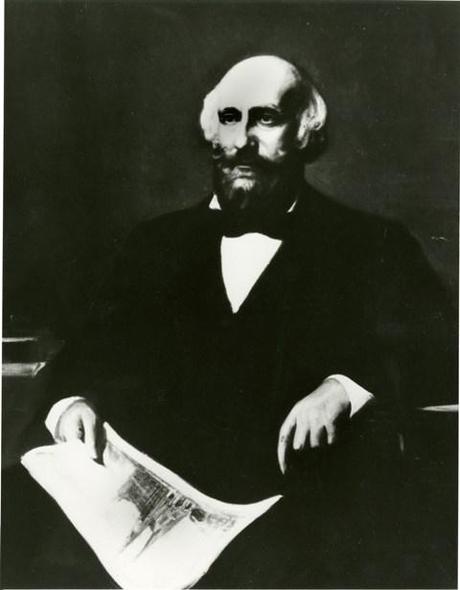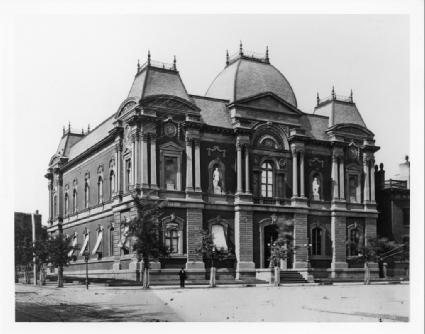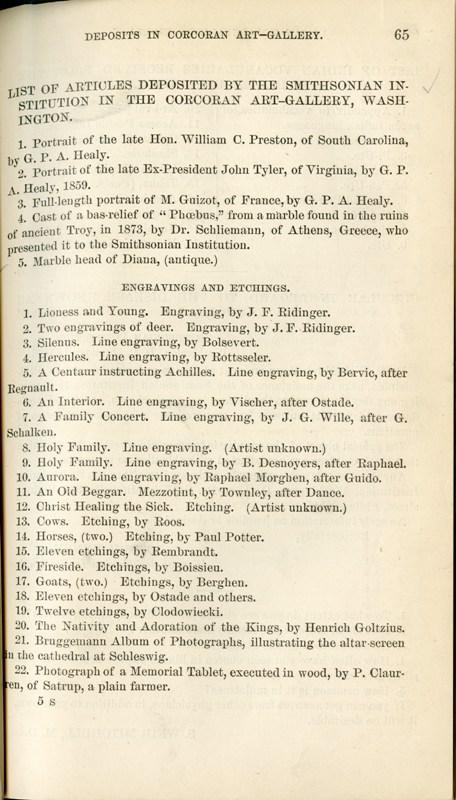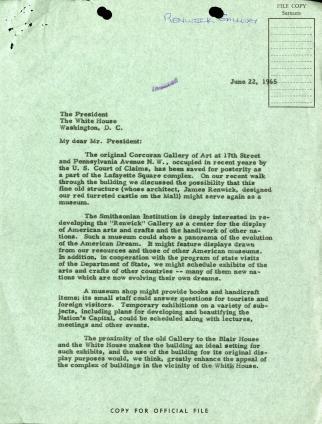The history of American Art's Renwick Gallery is a rich one. Recently, The Bigger Picture, the blog of the Smithsonian Institution Archives posted a story about the Renwick during the Civil War written by Intern Aly DesRochers. We thought it would be interesting to our readers as well.
At the corner of Pennsylvania Avenue and 17th Street NW sits the Renwick Gallery, a branch of the Smithsonian American Art Museum. Today, the notable building is filled with works that exemplify American crafts and decorative arts, but before art collections ever graced its halls, the building was loaded with stock of a different sort. The Renwick Gallery was first packed with supplies of the union troops during the Civil War. Later it had a brief tenure displaying the collection of the building's original owner, William Wilson Corcoran, and then a long term holding court offices, until finally being restored to its original purpose.

James Renwick, Jr., 1853, by John Whetten Ehninger, photograph of oil painting on canvas, courtesy of the Avery Library of Columbia University, Smithsonian Institution Archives, Record Unit 95, Box 19, Folder 18, Negative Number SIA2011-1485.
Corcoran was a banker and philanthropist in nineteenth century Washington, DC. His financial firm, Corcoran and Riggs, was a substantial money lender to the US government and our own Smithsonian Institution. Such successful ventures gained Corcoran a fortune, and he put his money to good use, collecting many notable artworks by American artists. By 1858, his collection had grown so immense that he sought to build a gallery to house and display it.
He chose the site for his gallery on Pennsylvania Avenue, in the heart of the city and neighboring the White House. As architect, he chose James Renwick, Jr., who had earlier designed the Smithsonian Institution Building, or "Castle." Having completed one DC icon, Renwick began work on the next in 1859, constructing the Corcoran Gallery in the Second-Empire style of Paris's recently opened museum of art, the Louvre. By 1861, construction of the exterior was nearly complete.

The original Corcoran Gallery of Art, now the Smithsonian Institution's Renwick Gallery, late 19th century, by an unknown photographer, photographic print, Smithsonian Institution Archives, Record Unit 95, Box 34, Folder 24, Negative Number SIA2008-2351.

Montgomery C. Meigs, Quartermaster General of the Union Army during the Civil War, c. 1860s, by an unknown photographer, Smithsonian Institution Archives, Record Unit 95, Box 17, Folder 3, Negative Number 2002-10683.
That same year, however, the outbreak of the Civil War interrupted Corcoran's plans. Corcoran himself was known as a Southern sympathizer, and when the war began he lost many friends in Washington, the seat of the Union government and war effort. At one point in 1861, he was briefly arrested, and for the remainder of the war he avoided the northern animosity in Europe. Sequestered across the Atlantic, Corcoran could not object to the Union government's seizure of his unfinished gallery of art, along with many other of his properties.
From his nearby office at 17th and F Streets, Quartermaster General Montgomery C. Meigs recognized the utility of Corcoran's building. With the walls and roof completed, the broad, high-ceilinged halls were ideal spaces to hold the overflow of uniforms and other materials that Meigs was charged with organizing and distributing. On August 22, 1861, he claimed Corcoran's would-be art gallery as the Union Army's warehouse. In 1864, his expanding department moved its headquarters into the building, a convenient location providing the Quartermaster General with easy access to President Lincoln in the White House.

List of Articles Deposited by the Smithsonian Institution in the Corcoran Gallery of Art, 1874, Smithsonian Institution Archives, Reading Room, Annual Report of the Smithsonian Institution for 1874, Negative Number SIA2011-1461.
Meigs vacated the building following the end of the war in 1865, but the US government held it until 1869, when it was returned to Corcoran's control. The Corcoran Gallery of Art officially opened in 1874, 15 years after construction on its building had commenced. Objects on display included some of the Smithsonian's art collection, which were loaned to the Corcoran Gallery in 1874 because Smithsonian Secretary Joseph Henry felt that the art objects were "scarcely in place in the midst of specimens of natural history in the Smithsonian Institution Building, or 'Castle', but would produce a better effect in connection with other works of art of a similar character." The art works were returned to the Smithsonian in 1896 after Henry's death.
However, Corcoran's ever expanding collection once again required additional space, and in 1897 the new, and current, Corcoran Gallery opened just three blocks south at 17th and E Streets. From 1899 to 1964, the Renwick Building was used as the US Court of Claims Office.

Letter Smithsonian Institution Secretary S. Dillon Ripley to President Lyndon B. Johnson regarding the Renwick Building (click through to see larger image), June 22, 1965, by S. Dillon Ripley, Smithsonian Institution Archives, Record Unit 99, Box 69, Folder 1, Negative Number SIA2011-1433.
Recognizing the importance of the building and its heritage, in 1965 Smithsonian Secretary S. Dillon Ripley asked President Lyndon B. Johnson to turn it over to the Institution. Ripley’s request was granted, and, nearly 100 years after Corcoran’s gallery, the Renwick Gallery opened its doors to the public in 1972, exhibiting the best examples of American crafts and decorative arts, and fulfilling this exquisite building’s intended purpose.

